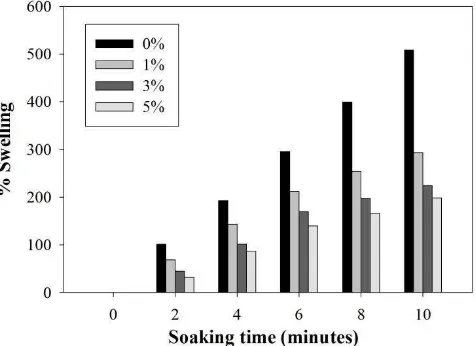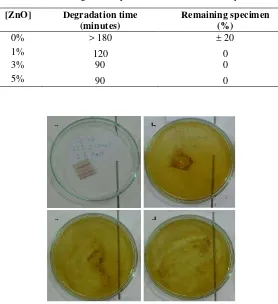This content has been downloaded from IOPscience. Please scroll down to see the full text.
Download details:
IP Address: 203.114.224.229
This content was downloaded on 28/08/2017 at 07:10
Please note that terms and conditions apply.
View the table of contents for this issue, or go to the journal homepage for more
Study of the influence of ZnO addition on the properties of chitosan-banana
starch bioplastics
L Sapei, K S Padmawijaya, O Sijayanti and P J Wardhana University of Surabaya, Surabaya 60293, Indonesia
E-mail: lanny.sapei@staff.ubaya.ac.id
Abstract. Plastics have been widely used in our daily life due to their relatively low cost and practical uses. However, plastics are hardly degraded and thus creating lots of environmental problems. Bioplastics have been developed in order to replace the conventional plastics since they are easily degraded and environmentally friendly. In this research, chitosan-banana starch bioplastics were made with the ratio of 70:30 in the presence of 30% glycerol as the plasticizer. ZnO with varying concentrations of 1, 3, and 5% were added into the biopolymer mixtures before casting in order to improve their mechanical properties. It turned out that 3% ZnO significantly increased the bioplastics tensile strength up to ~36MPa. Vice versa, elongation and swelling percentage were decreased as ZnO concentrations increased. Bioplastics prepared with 3% ZnO were degraded within relatively short time in 90 min. These chitosan-banana starch bioplastics reinforced by ZnO seems quite promising to substitute some commercial conventional plastics.
1. introduction
Plastic production has been rapidly growing since the beginning of 20th century. Plastics have
been very useful for our daily life and become an integral part of human life. It has been widely used
for many applications due to its versatilepractical use, lightness, convenience and relatively low-cost.
However it has been creating an accumulated environmental problem since plastics have been hardly
degraded in the nature. Due to an increasing demand of eco-friendly packaging materials, renewable
and biobased plastics such as chitosan/ protein/ starch based bioplastics have been increasingly
developed [1-4]. However, the composite bioplastics were generally still lacking of the mechanical
properties, thus some fillers such as cellulosic fiber [5] or particles i.e. clay [6], bentonite [7], SiO2 [8],
ZnO [5, 9, 10] were added to improve their mechanical properties. Over recent years, ZnO has become
a considerable research interest due to its low cost, easy bioavailability, biocompatibility and
possibility of performing surface modifications with different functional groups [11]. It is a non-toxic,
environmentally friendly material and shows an antimicrobial activity [11-13]. It is also ideal to be
used as reinforcing fillers in polymer composites since it possesses exceptional mechanical properties,
low coefficient of thermal expansion, and high thermal conductivity [11].
According to our previous investigation, bioplastics derived from chitosan and banana starch
(70:30) with the addition of 30% glycerol as the plasticizer showed a relatively high elongation of
2
was thus expected to be able to significantly enhance the tensile strength of the plasticized
chitosan-banana starch bioplastics. The objective of this study was to investigate the effect of varying ZnO
concentrations on the overall mechanical properties, swelling behaviour, as well as biodegradability
process of bioplastics.
purchased from Institut Pertanian Bogor (Bogor, Indonesia). It was derived from shrimp shell and was
pale yellow in color. Its de-acetylation degree was 88.5% and viscosity was 20 cps. Technical ZnO
powder and technical NaOH flakes was purchased from PT. Brataco (Surabaya, Indonesia).Glacial
acetic acid was purchased from PT. Merck Tbk (Indonesia). EM4 (Effective Microorganisms 4)
solution containing mixed microbial cultures (Lactobacillus 8.7 x 105; phosphate solubilising bacteria
7.5 x 106; yeast 8.5 x 106 some actinomycetes and photosynthetic bacteria in mineral containing
solution) was purchased from PT. Songgolangit Persada (Jakarta, Indonesia). Deionised water was
used during the experiments.
2.2. Methods
2.2.1. Preparation of chitosan-starch bioplastics
Chitosan-starch bioplastics were prepared with chitosan:starch ratio of 70:30 (v/v). ZnO particles were
added to improve the mechanical properties of the bioplastics. Chitosan solution was prepared by
adding 2.8 g chitosan into 70 mL 1% (v/v) acetic acid solution. The emerging gas bubbles had to be
removed out prior to mixing with the other ingredients. Starch slurry was prepared by suspending 1.2
g banana starch into 20 mL 1% (v/v) acetic acid solution. The slurry was then heated to its initial
gelation temperature of 55oC while stirring. ZnO as an additive was weighed depending on its
concentration (1, 3, 5%) in the mixture. ZnO particles were added into 10 mL of 1% (v/v) acetic acid
solution and then mixed until they were homogenously dispersed in the solution. Afterwards, chitosan,
starch and ZnO in aqueous solution were mixed together and 30 mL of glycerol was added in order to
have chitosan-starch-ZnO:glycerol ratio of 100:30 (v/v) or 30% (v/v) glycerol relative to the polymer
mixtures. Finally, casting of bioplastics was conducted by pouring the final mixture into a petri dish
several minutes and carefully removed out. The bioplastics were then rinsed under the flowing water
and dried at room temperature prior to analysis.
2.2.2. Mechanical Properties Measurement
The mechanical properties of bioplastics in terms of tensile strength and elongation percentage were
measured using an Autograph AG-10TE (Shimadzu, Japan). Bioplastics specimen with the dimension
of 7 cm x 2 cm was prepared. The specimen thickness was measured using a thickness gauge
instrument (Mitutoyo, Japan). Tensile strength was performed by elongating the specimen and the load
carried by the specimen before breaking was measured. Tensile strength was calculated by dividing
the maximum load by the original cross-sectional area of the specimen.
(1)
where F was measured load before breaking and A was cross-sectional area of the specimen (width x
thickness).
Elongation was calculated as the percentage increase in length that occurred before the specimen was
broken under tension.
(2)
Where L was the final length of specimen before breaking and L0 was the initial length of specimen.
2.2.3. Swelling Behavior Analysis
A specimen of bioplastics was immersed in water up to 10 min and the weight was monitored every 2
min. Bioplastics were dried up prior to weighing. Swelling percentage could be calculated as
(3)
Where W0 = initial sample weight and W = final sample weight.
2.2.4 Biodegradability Test
Bioplastics were cut into 2 cm x 2 cm and put into a petri dish. Afterwards, 20 mL microbial solution
(EM4) which was previously diluted for 5 times was added. The physical changes of bioplastics such
as changes in size, thickness, and color during the degradation processes were observed every 30 min.
3. Results and Discussion
Chitosan-starch (70:30) bioplastics containing 30% glycerol was reinforced with varying
4
Figure 1. The influence of ZnO Concentration on Mechanical Properties of Chitosan-Starch (70:30) Bioplastics containing 30% Glycerol. a) Tensile Strength; b) % elongation.
It was obvious that tensile strength tended to increase with the increase of ZnO concentration up
to 3% and slightly decreased when ZnO concentration was increased to 5%. There was a significant
increase of about 15 times when bioplastics 3% ZnO was incorporated in contrast to that without ZnO
addition. The highest tensile strength achieved upon the addition of 3% ZnO was ~36MPa which was
much higher in comparison to the highest tensile strength of cassava based starch bioplastics of about
32 MPa after being reinforced by 9% ZnO [5]. The addition of nano-ZnO up to 4%wt into glycerol
plasticized-pea starch only increased the tensile yield strength from 3.94 to 10.80 MPa [10]. The
tremendous increase in tensile strength of ZnO reinforced bioplastics in our experiment could be
caused by the use of chitosan as the backbone of the matrix which inherently possess higher tensile
strength. Tensile strength was increased as the chitosan ratio relative to the banana starch was
increased [1].
Figure 2. Swelling behaviour of chitosan-starch (70:30) bioplastics containing 30% glycerol upon the addition
of varying concentrations of ZnO.
Vice versa, the elongation was decreasing as the ZnO concentration was increasing. The
elongation was dropped from ~28 to ~8% when 3% ZnO was incorporated into the bioplastics. There
were no significant changes in elongation when ZnO concentrations were varied within the ranges of 1
to 5%. Concentration ZnO of 3% was then taken as the optimum due to its significant effect on the
improvement of the tensile strength.
The water uptake ability of bioplastics was significantly decreased upon the addition of ZnO.
The higher the concentration of ZnO, the lower was the swelling percentage (Figure 2). Bioplastics
without ZnO addition underwent swelling quite easily mainly due to the presence of glycerol. ZnO
tended to retard the swelling process of the bioplastics since it was hardly soluble in water. This
finding was in line with the previous research incorporating ZnO into bioplastics [9-10]. Furthermore,
swelling percentage was increasing with time in all cases.
Table 1. Biodegradability tests of chitosan-starch bioplastics.
[ZnO] Degradation time Remaining specimen
Finally, the biodegradability of chitosan-starch bioplastics reinforced by ZnO was tested by
immersing the bioplastics into mixed microbial EM4 solution. From Table 1, it turned out that the b
c d
a
6
contrast to that without ZnO addition. The biodegradability of the bioplastics tended to increase with
the increase of ZnO concentration. The biodegradability process of bioplastics reinforced by 3% ZnO
was completely vanished within 90 min as depicted in Figure 3.
ZnO has been known as an antimicrobial agent [11-13] so that it was supposed that ZnO was
able to retard the biodegradation process of bioplastics. However, ZnO could act as a catalyst in the
hydrolytic degradation of biopolymers [14]. The incorporation of ZnO into the plasticized
chitosan-starch bioplastics not only increased the tensile strength but also helped accelerate the biodegradation
process of bioplastics immersed in the microbial solution. The specific role of ZnO on the
biodegradability mechanisms needs to be further investigated. This research showed the immense
potential of ZnO as an additive for enhancing the mechanical properties of eco-friendly bioplastics.
This bioplastics could replace the commercial conventional packaging plastics.
4. Conclusions
The incorporation of ZnO particles into the plasticized chitosan-starch bioplastics (70:30) has
improved the mechanical properties of the biocomposites. The optimum ZnO concentration of 3% was
found to increase the bioplastics tensile strength of about 15 times from ~2.5 to ~36 MPa. The
elongation percentage as well as swelling percentage of bioplastics was decreasing with the increase of
ZnO concentration. Furthermore ZnO addition helped accelerate the biodegradability process of
bioplastics. These results suggested that ZnO could have become a potential filler to be used for
reinforcing bioplastics while also supporting the bioplastics recycling ability towards the
environmentally-friendly waste management leading to the sustainability living of the next
generations.
Acknowledgements
We wish to thank Ms. Dyah Ayu Ambarsari for the technical assistance during the experiments
conducted at Polymer and Membrane Laboratory, University of Surabaya, Surabaya, East Java,
[6] Mbey J A et al 2012 Carbohydr. Polym. 88 213-22. [7] Sarifuddin N and Ismail H 2013 Bioresources 8 4238-57.
[8] Torabi Z and Nafchi M A 2013 J. Chemical Health Risks 333-42. [9] Alebooyeh R et al 2012 J. Chemical Health Risks 213-6.
[10] Ma X, Chang P R, Yang J and Yu J 2009 Carbohydr. Polym. 75 472-8.
[11] Díez-Pascual A M and Díez-Vicente A L 2014 ACS applied materials & interfaces 6 9822-34. [12] Xie Y et al Appl. Environment microbial. 772325-31.

